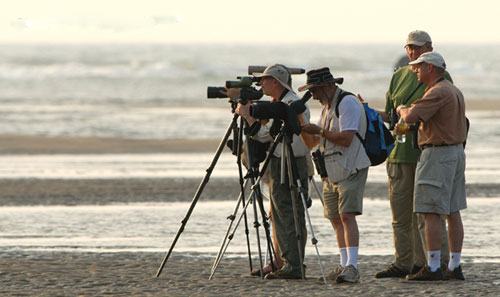
Birding on the beach in Goa Photo: Steve Matherly
Lying on the Arabian Sea well within the Tropic of Cancer and approximately 250 miles south of Bombay, India, the restful haven of Goa offers balmy seas, cloudless blue skies, endless white sand beaches fringed with palms, and stunning sunsets coupled with a novel blend of European culture and Indian ambience.
Goa is also a birdwatcher’s paradise with many excellent habitats: wide river estuaries, mangrove swamps, marshes, scrub-covered hillsides, arid fields, rich forest reserves at the foot of the majestic Western Ghats and a spectacular bird-thronged lake at Carambolim. We’ll explore most of Goa’s major birding sites and familiarize ourselves with a wide selection of its birds. We’ll encounter many species endemic to peninsular and south India as well as a large number of wintering species from farther north and more widespread Asian birds.
Wonderful birds, a sub-tropical environment, delicious food and the easygoing Goan lifestyle: it’s almost too good to be true.
NEW: We are now offering a post-tour option to join our India: Forest Owlet in Maharastra short tour to search for this recently rediscovered bird. Details on this exciting extension are available at the proceeding link. Those wishing to join the Forest Owlet tour from Goa would fly from Goa to Mumbai early on the last day of the Goa tour.
Day 1: The tour begins this evening in Goa.
Day 2: After an introductory meeting, we’ll spend the rest of the day getting to know some of the common birds close to our hotel. These should include the ever-present Brahminy and Black Kites, Indian Pond Herons, Eastern Cattle Egrets, Indian Rollers and Black Drongos. Blyth’s Reed Warblers and striking Black-rumped Flamebacks are common and we are bound to encounter both. Night in northern Goa.
Goa was excellent and Paul Holt’s leadership is among the very best. He was knowledgeable, considerate, patient and totally committed to the participant’s well-being.
Chris Duthie, Dec 2015
Days 3-12: We’ll spend these days getting to know Goa and its birds. A small marsh not very far from our hotel can hold a fine selection of birds and if the rains have been good we can look for Cinnamon and Black Bitterns, Greater Painted-Snipe, Black-winged Stilt, Marsh Sandpiper, Small Pratincole, Red-wattled Lapwing, Pacific Golden-Plover, Pintail Snipe, White-breasted Waterhen, Watercock, Slaty-breasted Rail, Ruddy-breasted and Baillon’s Crakes, Rosy Starling, White-breasted and Pied Kingfishers, and a host of smaller birds including Malabar Crested Lark, and Blyth’s, Richard’s and Paddyfield Pipits. Elsewhere, common birds we can expect to find include dazzling Little Green Bee-eater, Asian Koel, Long-tailed Shrike, Indian Robin, Wire-tailed Swallow, Ashy Wood-swallow and Green Warbler, while an Oriental Honey-buzzard or White-bellied Sea Eagle may drift overhead.
On some days, we’ll leave the coast and head inland to explore the forests of the Western Ghats. We’ll visit Bhagwan Mahaveer Wildlife Sanctuary (Mollem), not far from the village of Dhargem which boasts a Hindu temple dating back to the 11th century. The mixture of woodland, paddies, and small fields here offer a wonderful selection of birds. We’ll search the undergrowth for a star of the region, the jewel-like Indian Pitta, and may also come across a stunning Orange-headed Thrush, or a White-rumped Shama. The latter is arguably among the best songsters in the world. Among the open woodland and bamboo groves we’ll hope to find such charismatic species as Grey Junglefowl, White-bellied and Heart-spotted Woodpeckers, Malabar Pied Hornbill, Grey-fronted Green Pigeon, Velvet-fronted Nuthatch, Greater Racket-tailed Drongo, Black-naped Oriole, and Malabar Whistling Thrush.
We may find ourselves in the middle of a mixed feeding flock full of such gems as Yellow-browed, Grey-headed, and Flame-throated Bulbuls - this last stunning species being Goa’s state bird. These in turn may be joined by the equally stunning Asian Fairy Bluebird, Dark-fronted Babbler, Asian Paradise-flycatcher, White-bellied Blue Flycatcher or Indian Blue Robin. The birding does not stop when night falls either and we’ll go out at least once after dark (or before light) in the hope of finding Oriental and Indian Scops Owls, Brown Fish-owl and, with luck, Spot-bellied Eagle Owl. However, perhaps the star of any nocturnal birding will be the strange Sri Lanka Frogmouth whose equally strange, eerie grating call is so distinctive.
On other days we’ll visit Bondla Wildlife Sanctuary where many of these same birds can be found with some - the relatively rare White-bellied Blue Flycatcher and Forest Wagtail for example - in better numbers than at Mollem.
There is no fixed itinerary; instead Paul will use his knowledge of the area to decide each day how and where the excursions will run. At the same time he’ll ensure that all the main birding habitats in Goa are visited - some of them several times. All the sites are within a comfortable two hour’s drive from our hotel and most are much less.
Sites that we’ll visit will include the Baga fields; Fort Aguada (where we’ll look for Indian Peafowl, Sykes’s Warbler and Blue Rock Thrush); Fort Tiracol for the elusive Jungle Bush-quail; Candolim marsh, the Nerul bridge and the Santa Cruz pools and paddies for shorebirds; Dona Paula and Neura for arid grassland species such as Yellow-wattled Lapwing and Ashy-crowned Finch-lark; Mayem lake; Tikanem, Chorao and Divar Islands for Lesser Adjutants and Carambolim lake, and Bondla Wildlife Sanctuary. We will also spend part of one day sightseeing in Old Goa.
While we won’t be frequenting Goa’s famous (and often crowded) white sand beaches, we will visit one in particular, Morjim at the mouth of the Chapora River. It’s relatively quiet and normally holds thousands of gulls and terns. We will visit this beautiful site at least twice and hope to see up to six species of gulls, including several impressive Great Black-headed Gulls, and perhaps as many as nine or ten tern species, including both Lesser and Great Crested. Both Brahminy Starlings and Barred Buttonquail are occasionally found here, and the river mouth also holds a large gathering of shorebirds, including large numbers of Greater and Lesser Sandplovers, a few Terek Sandpipers and Common Redshanks, and a smattering of less common species such as Great Knot and at least in 2016 Crab-Plover. On one day we’ll travel by boat to the backwaters and creeks of one of the State’s larger rivers where we hope to encounter the endemic Goan subspecies of Collared Kingfisher as well as Woolly-necked Stork and the aptly named Mugger Crocodile.
We’ll visit a harrier roost that contains good numbers of ghostly Pallid Harriers, while Booted Eagle and both Greater and Indian Spotted Eagles are fairly common. We also have several reasonably reliable sites for Black, Rufous-bellied and Crested Hawk-eagles.
For non-birders Goa offers a great variety of activities and entertainment. This lively, friendly resort has numerous shops, restaurants and bars as well as abundant sunshine, sandy beaches and varied sightseeing opportunities. A variety of optional sightseeing trips are included, one of them out to the former Portuguese capital at Old Goa, which in its fifteenth-century heyday was the largest and richest city in the whole of Asia and whose a population then exceeded that of London! There is also the chance to visit some of the local markets. Nights in northern Goa.
Day 13: The tour ends this morning in Goa.
Updated: 27 August 2020
Prices
- 2024 Tour Price Not Yet Available
- (2023 Tour Price $3,490)
Notes

Questions? Tour Manager: Erin Olmstead. Call 1-866-547-9868 (US or Canada) or (01) 520-320-9868 or click here to email.
* Tour invoices paid by check carry a 4% discount. Details here.
Maximum group size 12 with one leader.
